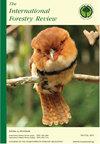东南亚森林生物安全法:综述
IF 0.9
4区 农林科学
Q2 FORESTRY
引用次数: 1
摘要
亮点目前,东南亚国家没有专门的生物安全法律或立法来关注与森林入侵害虫相关的风险和危害。挑战在于制定一项生物安全政策,并在不同国家的相关部门、研究所和植物健康组织中实施。从拥有完善的生物安全框架的国家转移知识将有助于制定森林生物安全法律和立法。发展生物安全技术能力(监测、监测和PRA)对于支持森林生物安全政策至关重要。可以通过成立一个森林生物安全工作组,作为东盟森林产品工业俱乐部(AFPIC)的一个小组委员会,报告生物安全联络点,来实施森林生物安全法律和立法的区域办法。总结为了确保东南亚的天然林和人工林得到保护,至关重要的是要将入侵性和本地害虫带来的风险降至最低,并制定有效的缓解和应对计划。为此,需要制定森林生物安全法,以协调政策,指导实地活动,为该地区应对入侵做好准备,并授权相关机构采取行动。在这篇综述中,我们概述了六个东盟国家与林业部门相关的现行法律和立法,并就可以制定的森林生物安全法提出了建议。我们就如何制定这些法律提出了一般性建议,重点是森林生物安全的区域方法。这可以通过成立一个森林生物安全工作组作为东盟森林产品工业俱乐部的一个小组委员会来实施,以促进成员国本土和人工林入侵害虫的全球安全。本文章由计算机程序翻译,如有差异,请以英文原文为准。
Forest Biosecurity Laws in South-East Asia: A Review
HIGHLIGHTS Currently, countries in South-East Asia have no dedicated biosecurity laws or legislation that focus on the risk and harm associated with forest invasive pests. The challenge is to create a biosecurity policy and implement it across relevant departments, institutes, and plant health groups in the different countries. Transfer of knowledge from countries with well-established biosecurity frameworks will support development of forest biosecurity laws and legislation. Developing technical biosecurity capacity (monitoring, surveillance, and PRA) is critical to support forest biosecurity policies. A regional approach to forest biosecurity law and legislation could be implemented through the formation of a forest biosecurity working group reporting on biosecurity focal points as a sub-committee of the ASEAN Forest Products Industry Club (AFPIC). SUMMARY To ensure the protection of natural and planted forests in South-East Asia, it is vital that the risks posed by invasive and local pests are minimised and that effective mitigation and response plans are in place. To do so, forest biosecurity laws need to be developed to coordinate policy, direct on-ground activities to prepare the region to respond to an incursion and empower relevant agencies to act. In this review, we outline the current laws and legislations relevant to the forestry sector in six ASEAN countries and make suggestions on forest biosecurity laws that could be developed. We put forward general recommendations on how these laws may be developed, with a focus on a regional approach to forest biosecurity. This could be implemented through the formation of a forest biosecurity working group as a sub-committee to the ASEAN Forest Products Industry Club, to promote global safety in invasive pests of native and planted forests of member countries.
求助全文
通过发布文献求助,成功后即可免费获取论文全文。
去求助
来源期刊

International Forestry Review
农林科学-林学
CiteScore
2.50
自引率
6.20%
发文量
29
审稿时长
>36 weeks
期刊介绍:
The International Forestry Review is a peer-reviewed scholarly journal that publishes original research and review papers on forest policy and science, with an emphasis on issues of transnational significance. It is published four times per year, in March, June, September and December. Special Issues are a regular feature and attract a wide audience. Click here for subscription details.
 求助内容:
求助内容: 应助结果提醒方式:
应助结果提醒方式:


